|
John
Wesley and Burslem
origin of
Methodists in Burslem in 1740
Wesley first preached in
Newcastle-under-Lyme as early as 1738 (the year of his conversion), not
visiting Burslem until March 8, 1760.
By this time, the Society of Methodists
in Burslem was already some 20 years old, having been established by a
group of miners around the year 1740 following their return from some of
Wesley's early meetings in Bristol. Thus, the "Swan Bank Methodist
Church" can claim to be one of the oldest Methodist Societies in the
world.
When Wesley arrived one of the converts, Abraham Lindop,
opened his cottage for services and in 1766 the first Methodist chapel in
Burslem was built.
|
Methodism continues to grow Wesley continued to
visit the Potteries and Burslem in particular, he often preached
at Hill Top in the Sytch.
Population growth - John Ward in his book 'The Borough of
Stoke-upon-Trent' estimates that around the time of Wesley's first
visit to Burslem the population of the whole of the Potteries was less
then 7,500 people. By 1785 it had doubled to 15,000.
Wesley notes this rapid influx of people, who had largely moved from
the countryside to take advantage of employment in the growing pottery
industry......
'1781, March 8th
- I returned to Burslem. How is the whole face of this country
changes in about twenty years! Since which, inhabitants have
continually flowed in from every side. Hence the wilderness is
literally become a fruitful field. Houses, villages, towns, have
sprung up: and the country is not more improved than the
people.....'
The Burslem Society continued
to grow after the building was erected in 1766 and in 1783 Burslem was
made head of a circuit.
The circuit system
was established in the early days of Methodism, when ordained
Methodist ministers were scarce. A minister would be appointed to a
group or circuit of local churches. He would administer the
sacraments and have pastoral oversight, but most of the services
would be led by the lay Local Preachers. Later, circuits came to be
staffed by several ministers, headed by a Superintendent Minister,
though there could still be more churches than ministers.
Wesley recorded...... '1784, March 31st
- I reached Burslem, where we had the first society in the county, and
it is still the largest, and the most earnest.' |
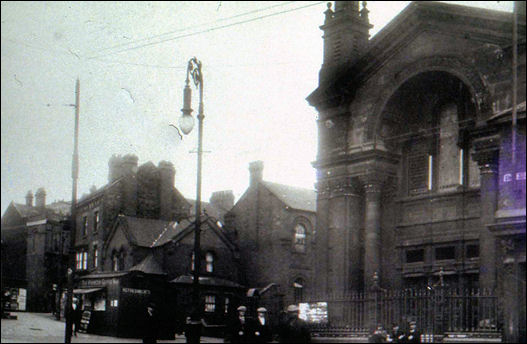
Burslem Wesleyan
Methodist Chapel and Sunday School Buildings
Swan Square, Burslem
photo: provided by Ewart Morris
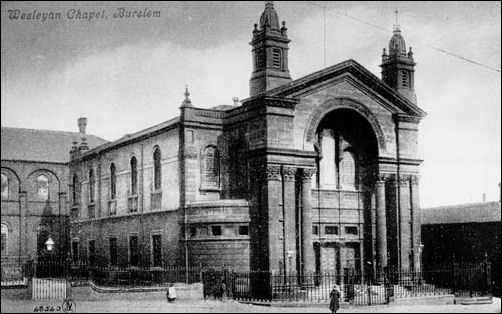
Swan Bank Wesleyan
Chapel, Burslem c.1890-1895
"the Corinthian facade of the Wesleyan Chapel"
Description:
"Three times on a Sunday - morning, afternoon, and Chapel at night..."
The first Wesleyan Chapel was built in the Potteries in 1766.
This was replaced by Swan Bank Chapel, shown in the photograph, in 1801.
In 1816 it was enlarged to seat 1290 people, before eventually being
replaced in 1971.
photo: © Potteries
Museum & Art Gallery
Staffordshire Past Track

Burslem Methodist
Mission
Swan Square, Burslem - Dec 2008
|
Key dates in Burslem
Wesleyan Methodist Society
The society was considerably weakened,
however, by the formation of the Methodist New Connexion in 1797.
In 1801 a new chapel was built in Swan
Square and enlarged in 1816.
The society again suffered a setback in 1836
on the division of the Burslem Sunday school.
In 1851 it was still the strongest chapel in
Burslem and seated 1,290; attendance then averaged 500 in the morning on
Sundays and 800 in the evening.
The chapel was again extended and improved
in 1870 when a new front with a portico was added. Vestries were added c.
1884. This is shown in the photo above.
In 1949 the chapel, which has always been
the centre of Wesleyan Methodism in the area, became The Central Methodist
Church and now (1958) forms a single church circuit.
The 1801 church building was demolished in
the late 1960's and a new modern church of concrete and brick was designed
by Hulme, Upright and Partners and completed in 1971.

Swan Bank Methodist
Sunday School Buildings
To the side and round the back of the modern church, the Sunday School
still stands in the school yard as marked on the 1898 map and exactly as
described by Arnold Bennett in his novel, Anna of the Five Towns.
photo: Dec 2008
"This Sunday School building
has two sections. The first is two storeys high, six rooms wide by two
rooms deep. The second building also has two storeys but is five rooms
wide by two rooms deep. They were constructed between 1832 and 1878, and
between 1878 and 1900."
The history of its Sunday school began in
1798. In 1801, when the new chapel was built, the school occupied
the old building and also used the Free School in Moorland Road and a
house in Hot Lane. In 1805 a new school adjacent to the chapel was
erected and had been enlarged by 1809. when the pupils numbered 1,260.
After the 1836 dispute, the school was
re-opened under the management of the Wesleyan trustees. New Sunday
and day school buildings were erected beside the chapel in 1850–1 at a
cost of £1,500, of which £400 was granted by the government.
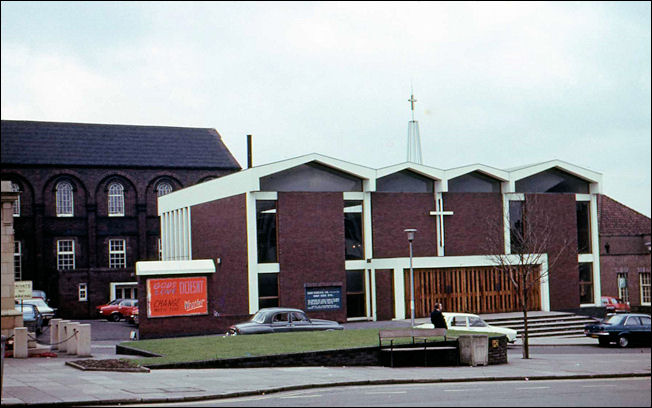
replacement building on
the same site as the original 1801 building
This modern church of concrete and brick was designed by Hulme, Upright
and Partners and completed in 1971
photo: Ewart Morris
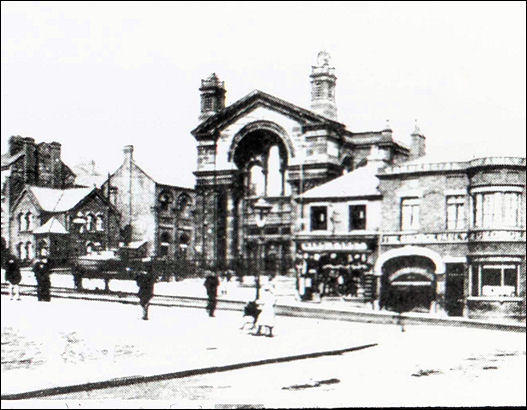
A view of Swan Square,
Burslem
the square is dominated by the portico of the Methodist Church (which
was added in 1870), on the right stands the old George Hotel
photo: provided by Ewart Morris
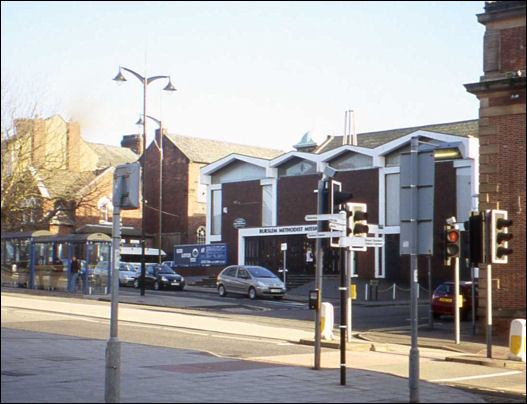
Same view with the 1971
church
the corner of the George Hotel, which was rebuilt after a fire of
1929, can be seen
|
Sources: 'The city of Stoke-on-Trent:
Protestant Nonconformity', A History of the County of Stafford: Volume
8 (1963).
Staffordshire Past Track
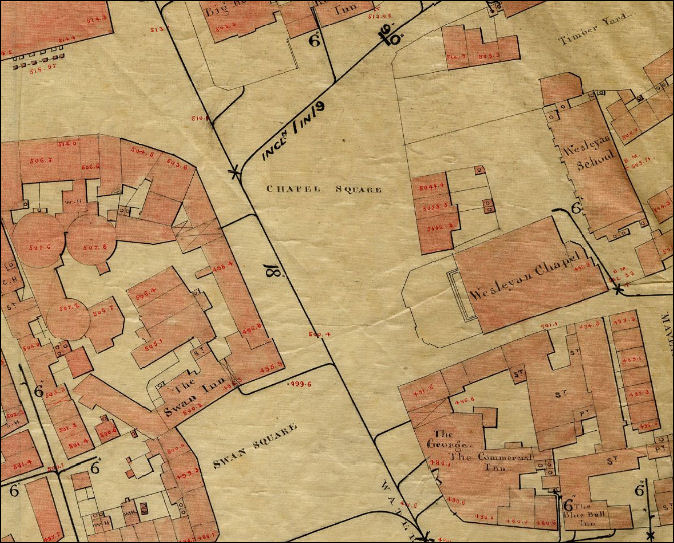
1851 map of Swan Square
and Church Square
showing the Wesleyan Chapel and School
© Staffordshire Past Track
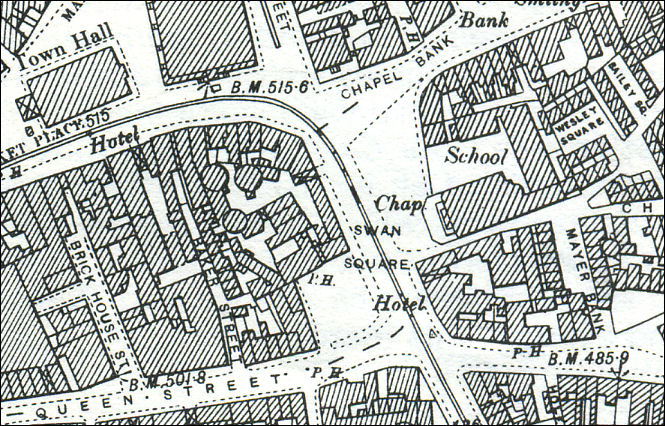
1898 map showing the
development of the school buildings

|
![]()
![]()
![]()
![]()
![]()
![]()